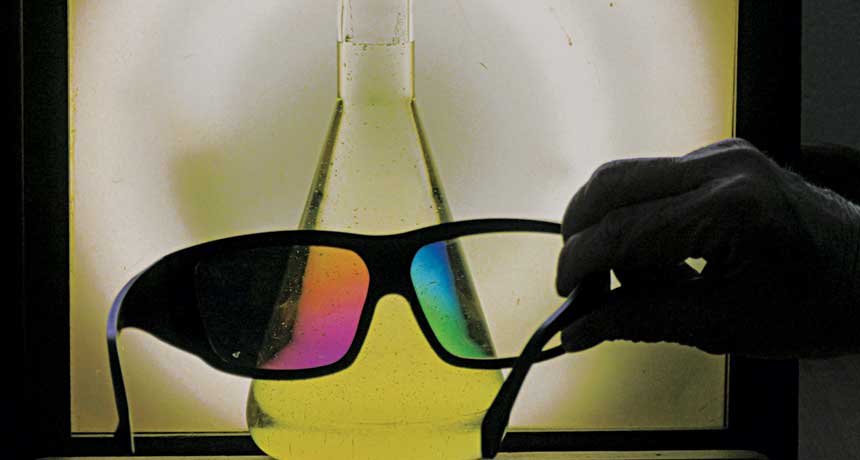A science-themed escape room gives the brain a workout
A quantum physicist discusses what he learned from starting LabEscape

SWEET SURPRISE To unlock hidden messages in LabEscape, players must discover tricks of light. In this example, sugar molecules in the flask rotate light’s polarization, or the orientation of its electromagnetic waves, revealing colors that are visible through polarized glasses.
P. Kwiat/LabEscape
- More than 2 years ago
Professor Schrödenberg is missing, and evil agents want to use her quantum computing research for nefarious purposes. Stopping them is up to you, but completing your mission will require solving some mind-bending puzzles —based on science.
If you are up for the challenge, you can test your wits at LabEscape, a science-themed escape room at the Lincoln Square Mall in Urbana, Ill. Escape rooms are a popular group activity, in which a team of players is enclosed in a room and must solve puzzles to either escape the room or accomplish a goal within a certain amount of time. LabEscape, created by a bona fide physicist and a crew of physics students, requires no previous scientific knowledge to play. But it does take a willingness to think creatively and work together as a team.
Science News had the opportunity to try out a different version of LabEscape in Boston at a meeting of the American Physical Society in March. In this case, the challenge was to decode the fictional Professor Schrödenberg’s password to submit her grant proposal. The tasks necessary to break the code had our small group, consisting of adults and children, scientists and science rookies, running from one side of the room to the other, fiddling with lasers, polarized glasses, thermal imaging cameras and more. Many puzzles required discovering the specific action necessary to reveal a cleverly hidden message — often eliciting excited gasps from our group. Solving one puzzle led to others, until finally, we cracked the code and saved the day.
The puzzles are effective and artistic, and some of the reveals seem almost magical until the purveyors explain the scientific principles behind them at the end of the game. For example, some puzzles required the use of polarized glasses like those used to watch 3-D movies. Those challenges provided an opportunity to discuss the polarization of light — the orientation of light’s wiggling electromagnetic waves in a preferred direction. Only waves with the appropriate polarization make it through the lenses. The principle also reveals how 3-D movies work: Different polarizations make it through the right and left lenses, sending a different image to each eye.
As of March, the nonprofit LabEscape has had about 4,500 visitors since it opened in January 2017. LabEscape’s creator, quantum physicist Paul Kwiat of the University of Illinois at Urbana-Champaign, has also brought incarnations of LabEscape to scientific meetings and is in discussions with science museums to host the room in the future.
Science News sat down with Kwiat to learn more about his foray into escape rooms. His inspiration, he says, was the first escape room he ever tried, in the summer of 2015 in Lausanne, Switzerland. He did not escape, but he realized that many of the demonstrations he used in lectures could be turned into puzzles to capture the attention of the unsuspecting public and teach scientific principles. The following discussion has been edited for length and clarity.
SN: What are your goals for LabEscape?
Kwiat: The first goal is to show people that science is accessible and relevant to them. The second is to show that science can be fun, because most people don’t think of “science” and “fun” without a “not” between them. And third is to have them see that science can be really beautiful, aesthetically. Then there’s a meta-goal, which is that it’s super important that people have a really good time.
SN: What kinds of teams perform the best?
Kwiat: Curiosity is the thing that people need to do well in an escape room. And that’s a case where kids can be really quite good. They’re very energetic; they really want to figure things out. The group [at the American Physical Society meeting] that had five high school students and two scientists was clearly superior to all the groups that had only scientists.
SN: What makes a good puzzle?
Kwiat: A good puzzle is hard to do, and when people find out the answer, in some sense it was obvious. Of course, it wasn’t really obvious because then you would have just done it. A bad puzzle is when the people running the room tell you no one’s ever gotten it without a hint.
SN: What have you learned by watching people solve puzzles?
Kwiat: I hadn’t anticipated people’s inventiveness. We have a puzzle in which people have to get a key out of a crate. We had a very particular vision in mind of how that should happen. And then people came up with another way to get the key out of the crate, and another way. Now there are 19 ways. It’s quite creative, and that’s absolutely fabulous for science. You’re not following a recipe; you’re discovering new things.







